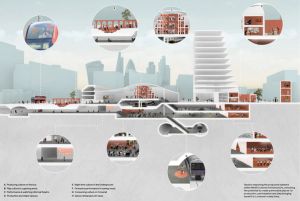Cultural Infrastructure: Metabolic Cities
1.0 MOBILITY & CULTURE We propose to exploit the opportunities generated by transport infrastructure developments, during “the journey” itself, by distributing new cultural spaces along the length of Crossrail, near its many stations to serve a wider demographic and bring benefit to Londoners’ daily lives. For this purpose we have studied the typical day in the life of a Londoner. We have analysed how technology, mobility and daily activities (such as sleeping, eating, playing, working etc.) overlap in the routine of an adult and a child respectively, and where in these cycles cultural production, participation and enjoinment tend to insert themselves. The journeys we make are active sites for cultural investment not just the destinations we travel to and from.
2.0 CREATE PERMISSIVE PLACES FOR PRODUCTION, PARTICIPATION AND PLAY Our proposal favours the proliferation of extra-small, small and medium sized flexible spaces, ideal for studios, workshops and rehearsal spaces, close to transport, this would support local talent and mitigate the incessant expansion of residential space as well as Large and Extra Large containers for the high-arts at the expense of London’s common creative ground.
3.0 REFORM EXISTING FUNDING MODELS We propose to allocate a fixed percentage of both Local Authority and Community Infrastructure Levy (CIL) – a planning charge that local authorities can impose on large developments– to support the economic and cultural wellbeing of an area. This levy would fund the provision of new spaces on sites that sit between the forthcoming Crossrail stations and their adjacent speculative developments, as well as further afield within local neighbourhoods. We have tested this proposal on two sites touched by Crossrail: Whitechapel and Heathrow Airport, revealing the huge potential these have to re-provide lost creative space.
4.0 MAKE MESS Our proposed cultural infrastructure network, will utilise the ‘shit space’ of development (the less valuable floor space of new buildings, such as the underground or overshadowed areas, or the noisy space in the proximity of an airport or railway line) to make room for MeSSy creative activities in our city. Borrowing the model of Shared Economy – essentially connecting and making the most of under used resources – less valuable venues will be programmed into new buildings, transport infrastructure itself and public spaces, to maximise their use and create more permissive spatial framework, where variety, hybridity and serendipitous discoveries can unlock the potential for creativity and play in the city.

In 2017, DSDHA led Metabolic City, a Design Think Tank at the London School of Architecture focused on the theme of Cultural Infrastructure. Responding to the then-upcoming Mayor of London’s Cultural Strategy, the project proposed spatial strategies to help sustain London’s identity as a global cultural capital.
While the city’s cultural life remains rich and diverse, it faces increasing threats—from rising property values that displace local and creative communities, to the privatisation of public collections and the loss of informal public spaces to overregulation.
At the same time, patterns of cultural consumption are shifting, with networked technologies and mobility fostering a more transient, informal engagement with culture. In response, DSDHA proposed MeSS(MEtabolic Spatial Strategies), a city-wide framework that reimagines cultural infrastructure at a granular scale.
By embedding flexible cultural spaces into the overlooked fabric of journeys and infrastructure, MeSS supports a more dispersed, accessible, and democratic cultural ecology that resists exclusive institutional models.